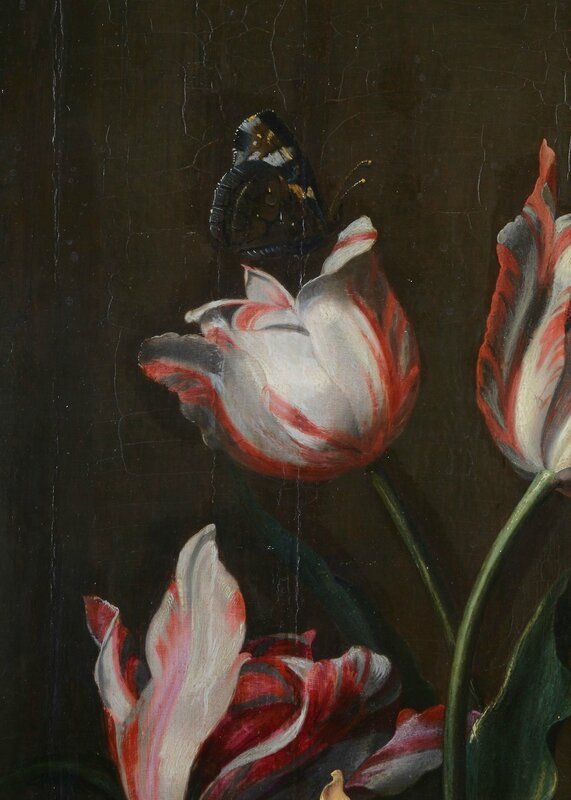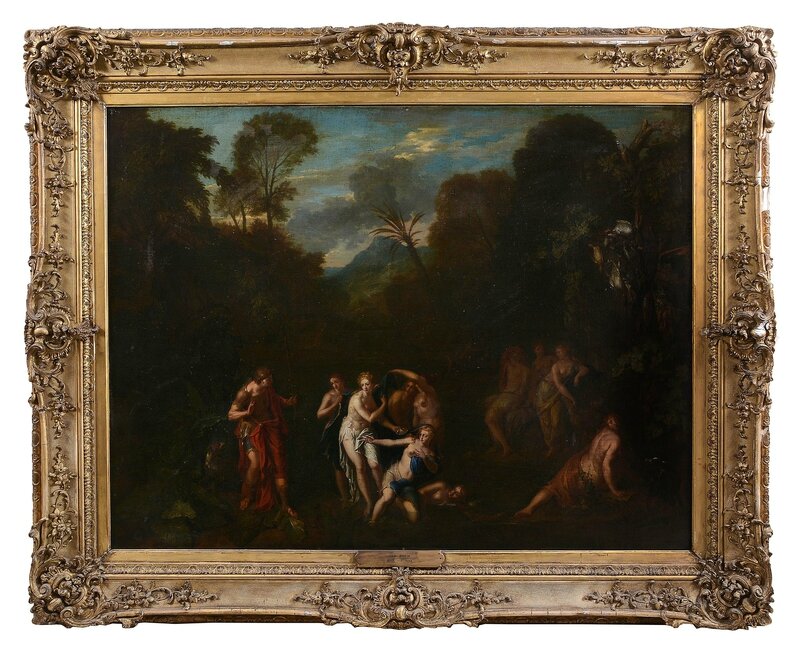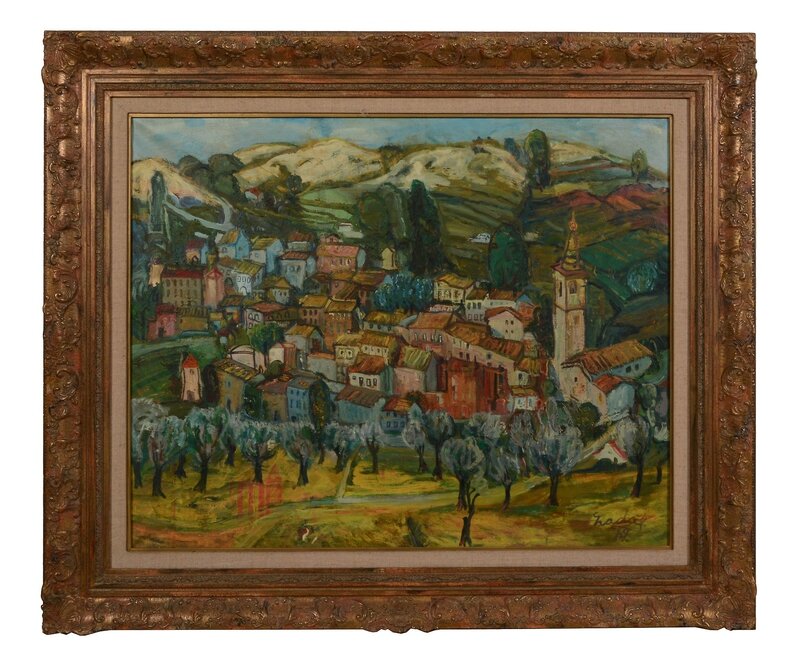Dreweatts & Bloomsbury Auctions hosts a sale of Fine Paintings on 13th July
Lot 9. Jean-Michel Picart (1600-1682), Still life with spring flowers on a ledge. Oil on panel, 63 x 47 cm. (24 3/4 x 18 1/2 in). Estimate £50000–70000.
LONDON.- Dreweatts & Bloomsbury Auctions will host a sale of Fine Paintings on Wednesday 13th July 2016 (10am) at Donnington Priory, nr. Newbury. Estimates range from £1,000-£70,000 with an estimated total sale value of £600,000.
Highlighting the auction is E 44 by Polish artist, Wojciech Fangor, estimated at £50,000-70,000. This painting forms part of a group of works from The Collection of the late Clifford and Rosemary Ellis which also includes an interesting group of drawings by Walter Sickert. Both artists taught at one time at the Bath Academy of Art, based at Corsham Court, which was founded by Clifford Ellis in 1946.
Lot 93. Wojciech Fangor (1922-2015), E 44. Oil on canvas. Signed, titled and dated 1966 on the reverse, 71 x 71 cm. (27 7/8 x 27 7/8 in). Estimate £50000–70000.
Wojciech Fangor was one of the most influential artists to emerge from post-war Poland. His distinctive blurred circles and cloud-like formations came to the notice of an American audience in the 1960s when it was included in “15 Polish Painters” (1961) at the Museum of Modern Art, New York and then four years later alongside Bridget Riley and Frank Stella in the seminal Op-Art exhibition “The Responsive Eye”, also at MoMa. These vibrant and densely coloured compositions were reminiscent of Color Field painting although in truth their inspiration was significantly different. Whilst Color Field artists such as Robert Motherwell, Frank Stella and Barnett Newman were primarily concerned with the application of colour on the flat picture plane, Fangor took his cue from an exploration of architecture. In the 1950s he had collaborated with an architect friend, Stanislaw Zamecznik on ideas about space, colour and public interaction.This culminated in an exhibition in 1958 entitled ‘Study for a Space’ considered to one of the first environmental exhibitions.Fangor was interested in the effect that the painting had on the space between the viewer and the canvas and the way in which this changed the viewer’s perception of their environment. In the later 1960s, after emigrating to the United States, he became a key figure in the Op-Art movement continuing to develop his theories on light and colour. In 1970, he was the first Polish artist to have a solo show at the Guggenheim Museum in New York. Between 1965 and 1966, prior to leaving for the United States, Fangor came to teach at Corsham Court in Wiltshire and the present painting dates from him time there. It is a dazzling example of a painter at the height of his powers with the colours merging enticingly before the viewer’s eyes. At once, somewhat unsettling to the vision, the simplicity and purity of form produce an almost hypnotic effect. Fangor was born to a wealthy family in Warsaw in 1922 and took private lessons from artists Tadeusz Pruszkowski and Felicjan Kowarski. After the end of the Second World War, when social realism became the ‘official’ style of Communist Poland, Fangor produced a number of political paintings which have since become regarded as some of the most canonical examples of Polish social realism.
The sale also includes a collection of ten works by the artist Fred Hall who is perhaps best known as a member of the Newlyn School of painters having settled in Cornwall in 1888. However, later in life, in 1911 he came to live in Speen, near Newbury where he remained until his death in 1948, aged 88. It was during this period that he came to know Harold Barton, senior partner at Dreweatt Watson and Barton, local agricultural auctioneers and land agents. Harold and his wife, Phyllis, became friends with Hall and helped to support him over the years. Harold would often take Fred on visits into the countryside, leaving him to paint for the day whilst he carried out his professional work. The majority of the present group of paintings were acquired directly from the artist and have remained in the family since. A number were exhibited at the Newbury District Museum in 1984.
Lot 69. Frederick Hall (1860-1948), Two Horses in the Shade. Oil on canvas. Signed lower right, 96 x 122 cm. (37 3/4 x 48 in). Estimate £5000–7000.
Also estimated at £50,000-70,000 is Still life with spring flowers on a ledge by seventeenth century Flemish artist Jean-Michel Picart. Picart was born in Antwerp and worked in Paris, where he died in 1682. This still life painting is typically characteristic of Picart’s style, which merged the simplicity of Flemish realism with the extravagant, richly draped floral arrangements painted for Louis XIV.
Lot 9. Jean-Michel Picart (1600-1682), Still life with spring flowers on a ledge. Oil on panel, 63 x 47 cm. (24 3/4 x 18 1/2 in). Estimate £50000–70000.
Jean-Michel Picart was born in Antwerp in 1600 where it is believed he trained in the Franken family studio from the age of 15. In 1635 he moved permanently to Paris. Picart established a successful career living in the Saint-Germain-des-Prés district. He specialised in depicting realistic still lifes, particular of luxurious flowers. In 1640 Picart became a member of the Saint Luke’s guild and worked both as a painter and a dealer in the city of Paris. He opened a workshop for young Netherlandish artists who made the move to Paris to start their careers and influenced the work of French artists Francois Garnier (c.1600-1672) and Augustin Bouquet (fl. 1625-1660). Picart’s style was influenced by the simplicity of Flemish realism and the extravagance of the floral motifs that decorated the court of Versailles for King Louis XIV. The present work illustrates a tall bouquet of luxurious flowers in a finely painted glass vase which stands out against the striking glossy black background, typical of Picart’s style.
The Dutch Golden Age spanned across the seventeenth century as a result of economic prosperity. Dutch trade was at the forefront of Europe and scientific development and artistic practice prospered. In particular, still life painting flourished in the Netherlands during the seventeenth century. Artists based in Antwerp, such as Frans Snyders (1579-1657) and Adriaen van Utrecht (1599-1652) popularised the style of still life painting that illustrated luxurious commodities, expensive fruit and exotic flowers.
Floral still lifes, in particular became prominent in the early 1600s and botanical interest flourished in the seventeenth century. It became popular for wealthy collectors, including the Holy Roman Emperor, Rudolf II, to own a garden with rare flowers and herbal specimens along with small libraries that included watercolours and drawings of rare flowers.
Flower paintings immortalised the beauty of nature. Flowers were appreciated for their beauty and fragrance. Tulips, in particular, were a great fascination for the Dutch. Arriving in the 1570s they remained a luxurious rarity until the mid-1630s. The Netherlands seized the opportunity and began trading in tulip bulbs. Speculation drove the market and the price paid for a single tulip bulb could purchase a house with a garden. The Semper Augustus tulip, famous for being the most expensive tulip bulb is finely painted in Picart’s still life. However, the two colours that dramatically spread across the petals is in fact caused by the Tulip Break Virus, it was this dramatic effect that caused great speculation on the tulip market.
We are grateful to Fred G. Meijer of the RKD/The Hague for confirming the present attribution on the basis of photographs (Private correspondence, May 2016).
Further Flemish highlights include an exquisite painting of Diana and Actaeon by Ludovicus Rijsbrack and Pieter Andreas Rijsbrack (fl. 1710-1720). This piece is part of the impressive selection of paintings for sale from Pen Moel, near Chepstow, estimated at £12,000-£18,000.
Lot 11. Ludovicus Rijsbrack and Pieter Andreas Rijsbrack, Diana and Actaeon. Oil on canvas. Bears indistinct signature lower right, 103 x 133 cm. (40 1/2 x 52 1/4 in). Estimate £12000–18000.
Provenance: Pen Moel, near Chepstow, since circa 1930s
For a comparative work, possibly originally painted as part of a group, showing the Discovery of Callisto, see Sotheby’s New York, April 7th, 1988, lot 33a.
Other highlights include Carlos Nadal’s striking landscape painting of Switzerland, Villagio, estimated to reach £20,000- £30,000 and Edward William Stott’s notable painting, Maternity (est: £12,000-18,000). The latter is a tender depiction of rural England described in The Art Journal at the time as ‘a temperamental little picture; it yields pleasure.’
Lot 75. Carlos Nadal (1917-1998), Villagio (Bedigliora, Ticino, Switzerland). Oil and mixed media on canvas. Signed and dated 79 lower right; signed and dated 76 (?) on the reverse, 81 x 100 cm. (31 7/8 x 39 3/8 in). Estimate £20000–30000.
Literature: Hubert Nyssen, Carlos Nadal, Edition d'Alain Barthélémy, 1980, p. 169, listed with the title 'Le Tessin' and date 72' (illustrated in black and white)
Exhibited: Barcelona, Sala Pares Gallery, 1980, with the title ¾di Ghora', (illustrated in the exhibition catalogue)
The authenticity of this work has been confirmed by the Comité Nadal.
Arguably the last of the Fauves, Nadal, despite being close friends with contemporaries such as Pablo Picasso, Georges Braque and Oscar Dominguez, was never tempted to stray too far into abstraction but remained faithful instead to representation and his Fauvist influences. His enduring love of the Fauvist movement is shown in the vibrant colour palette of the present work, which also exhibits his characteristic bold outlines, energetic brushwork and tilted perspective, inviting the viewer into the space.
The Medieval village of Bedigliora is located in the Swiss Alps and was visited by Nadal during 1979 in-between trips to New York in 1978 and 1980. The church of St. Roch, depicted in the present lot, dates from 1644, and was a central part of daily life in Bedigliora. In his painting, Nadal acknowledges the importance of the church by depicting it as a towering presence watching protectively over the rest of the village.
We are grateful to Alex Nadal and John Duncalfe for their kind assistance in cataloguing this lot.
Ceasefire, an oil painting by Peter Howson, one of his generation’s leading figurative painters, is expected to realise £10,000 to £15,000. Howson’s visceral paintings deal with issues of war and human suffering. He was appointed Officer of the Order of the British Empire in the 2009 Birthday Honours’ for services to the visual arts. However, in 2014 the artist rejected the OBE on the grounds he no longer wanted to be part of the British establishment.
Lot 112. Peter Howson (b.1958), Ceasefire. Oil on canvas. Signed and titled on the stretcher, 183 x 122 cm. (72 x 48 in). Painted in 1992. Estimate £10000–15000.
Peter Howson was born in 1958 in London. He moved to Scotland at the age of four where he studied at the Glasgow School of Art from 1975-1977 and 1979-1981 under Alexander Moffat. Influenced and encouraged by his mentor and friend Moffat, Peter Howson started to build his reputation in the 1980s as one of the central figures of the Scottish figurative painting movement - as a contemporary of Steven Campbell, Adrian Wiszniewski and Ken Currie.
Peter Howson's oeuvre comprises a range of different subjects: his early works are characterised by large format paintings depicting the Glasgow underclass - portraying an overtly working-class world showing mainly massive, predominantly male figures, sometimes even featured as nudes, portrayed in a bold, muscular style where Howson uses line and colour to strongly underline this expressive effect. The atmosphere of these works range from sympathy and tenderness to the seething hotbed of violence.
Peter Howson was fascinated by the fast growing body building culture; he was intrigued by the shadowy, the exotic unknown and sometimes even the violent world in his creative work - the grotesque form of over-developed figures was rising in the focus of his much-vaunted work.
“Howson's stated abhorrence of violent culture is reflected and often replicated in much of his work and there seems to be an intrinsic link between the potent, and sometimes literal, violence of his paintings and their depiction of muscle-bound monsters. His portrayals of Glasgow's down-and-outs and working class macho culture amidst the industrialised wasteland of Clydeside in the west of Scotland in the 1970s and 1980s gained him a vast amount of public and media attention." (Gracefield Art Centre, Dumfries, Peter Howson, Biography)
Later, in 1993, he accompanied a British contingent of the United Nations Peace Keeping Force in Bosnia as the Official British War Artist documenting the horrors of the civil war. During this period he produced some of his most shocking and controversial works detailing the abysses and atrocities of war.
In his recent works he has increasingly turned to Christian subjects.
Howson is both nationally and internationally widely collected and features in the National Galleries of Scotland as well as many private collections. Peter Howson is a recipient of numerous honours and was awarded the Henry Moore Foundation Prize in 1988. In 2009 he was appointed as an Officer of the Order of the British Empire (OBE).

/https%3A%2F%2Fprofilepics.canalblog.com%2Fprofilepics%2F1%2F0%2F100183.jpg)
/https%3A%2F%2Fstorage.canalblog.com%2F03%2F02%2F119589%2F96711876_o.jpg)
/https%3A%2F%2Fstorage.canalblog.com%2F11%2F31%2F119589%2F94773502_o.jpg)
/https%3A%2F%2Fstorage.canalblog.com%2F20%2F83%2F119589%2F94772815_o.jpg)
/https%3A%2F%2Fstorage.canalblog.com%2F26%2F72%2F119589%2F75604929_o.jpg)
/https%3A%2F%2Fstorage.canalblog.com%2F59%2F60%2F119589%2F26458628_o.jpg)




















/image%2F1371349%2F20240418%2Fob_ac5c4c_telechargement.jpg)
/image%2F1371349%2F20240418%2Fob_709b64_304-1.jpg)
/image%2F1371349%2F20240418%2Fob_22f67e_303-1.jpg)
/image%2F1371349%2F20240417%2Fob_9708e8_telechargement.jpg)